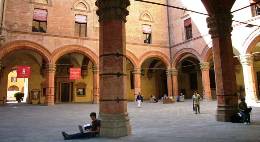Primary Education
In Italy, the debate rages on regarding the role of religion and its symbols in education. Meanwhile primary schooling remains free, after which parents must pay school fees through to age 16. After spending time at preschool (
scuola materna) children enter
scuola primaria (primary school) for 5 years. Here they learn the basics of computer studies, english, geography, italian, mathematics, music, science, social science and optional religious studies. All children who turn 13 in a particular year, go on to lower secondary school the following year.
Middle Education
Scuola Media or lower secondary school is mandatory too, although not free. There scholars follow a three year program nominally from age 11 to age 14. Minimum school hours are 30 per week. Up to 10 hours more may be financed by a school's own budget to provide tuition in computer skills, foreign languages, sports, music with own instrument, and chess. At the end of the third year, those who pass oral and written examinations receive a
diploma di licenza media.
Secondary Education
Upper secondary school (scuola superio) comprises an obligatory 2 years followed by a further optional 3. In the latter period students choose between attending a
liceo (something akin to a British grammar school) or an
instituto or vocational school. In all, there are 7 kinds of secondary schools in Italy, namely classical high schools, scientific high schools, fine arts high schools, teacher training schools, artistic schools, technical institutes, and professional institutes.
Vocational Education
Further vocational education involves practical certificated training in specific skills according to European Union standards. This broad approach facilitates cross-country training and experience, as a consequence of which Italian tradespeople and technicians are in demand world-wide.
Tertiary Education

Italian universities follow generally accepted tertiary education standards. Accordingly they offer courses towards bachelors, 1- and 2-year masters degrees, and doctorates. Other specialization schools provided advanced knowledge to those already with second-level degrees, while refresher courses aptly named
corso di perfezionamento enable professionals to top-up their knowledge.
Many of the oldest universities in the world are found in Italy. Among literally scores, the oldest are the University of Bologna that dates from AD 1088, and the University of Padua founded in the year 1222.

 Italian universities follow generally accepted tertiary education standards. Accordingly they offer courses towards bachelors, 1- and 2-year masters degrees, and doctorates. Other specialization schools provided advanced knowledge to those already with second-level degrees, while refresher courses aptly named corso di perfezionamento enable professionals to top-up their knowledge.
Italian universities follow generally accepted tertiary education standards. Accordingly they offer courses towards bachelors, 1- and 2-year masters degrees, and doctorates. Other specialization schools provided advanced knowledge to those already with second-level degrees, while refresher courses aptly named corso di perfezionamento enable professionals to top-up their knowledge.